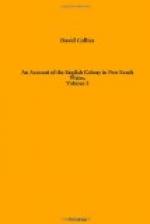Its length, from the tip of the tail to the tip of the nose, is thirty-one inches, of which its body takes up twenty-three and five-tenths. The head is seven inches, and the tail five-tenths. Its circumference behind the forelegs, twenty-seven inches; across the thickest part of the belly, thirty-one inches. Its weight by hand is somewhat between twenty-five and thirty pounds. The hair is coarse, and about one inch or one inch and five tenths in length, thinly set upon the belly, thicker on the back and head, and thickest upon the loins and rump; the colour of it a light sandy brown, of varying shades, but darkest along the back.
The head is large and flattish, and, when looking the animal full in the face, seems, excluding the ears, to form nearly an equilateral triangle, any side of which is about seven inches and five tenths in length, but the upper side, or that which constitutes the breadth of the head, is rather the shortest. The hair upon the face lies in regular order, as if it were combed, with its ends pointed upwards in a kind of radii, from the nose their centre.
The ears are sharp and erect, of two inches and three-tenths in length, stand well asunder, and are in nowise disproportionate. The eyes are small, and rather sunken than prominent, but quick and lively. They are placed about two inches and five tenths asunder, a little below the centre of the imaginary triangle towards the nose. The nice co-adaptation of their ciliary processes, which are covered with a fine hair, seems to afford the animal an extraordinary power of excluding whatever might be hurtful.
The nose is large or spreading, the nostrils large, long, and capable of being closed. They stand angularly with each other, and a channel is continued from them towards the upper lip, which is divided like the hare’s. The whiskers are rather thick and strong, and are in length from two to three inches and five tenths.
The opening of its mouth is small; it contains five long grass-cutting teeth in the front of each jaw, like those of the kangaroo; within them is a vacancy for an inch or more, then appear two small canine teeth of equal height with, and so much similar to, eight molars situated behind, as scarcely to be distinguishable from them. The whole number in both jaws amount to twenty-four.
The neck is thick and short, and greatly restrains the motions of the head, which, according to the common expression, looks as if it was stuck upon the shoulders.
From the neck the back arches a little as far as the loins, whence it goes off at a flat slope to the hindmost parts, where not any tail is visible. A tail, however, may be found by carefully passing the finger over the flat slope in a line with the backbone. After separating the hairs, it is seen of some five tenths of an inch in length, and from three to one tenth of an inch in diameter, naked, except for a few short fine hairs near its end. This curious tall seemed to hold a much bolder proportion in the young than in the full-grown animal.




